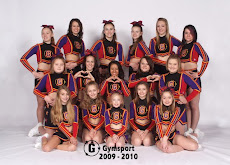This is the first installment of Where is my daughter?
Over the next few weeks I will be posting regarding the different levels in competitive cheer.
In competitive cheerleading they not only break teams up by age but by skill level. There are 5 levels for 18 year old cheerleaders and younger (there is a level 6 but this is for college age cheerleaders).
A common misconception with in the cheer parent community is that levels are mainly based on tumbling/gymnastics skills. Tumbling is one of the defining skills but also stunt and pyramids are defined. Judges also expect a level 3 team to have considerably better jumps than a level 1 team, just like they would expect a level 5 team to have considerably better dance than a level 3 team.
And just because a cheerleader might be able to perform (for example) a back handspring, does not mean that the back handspring is competition ready, or clean and safe enough to put into a routine.
At Gymsport the way we decide on a team's level is by taking the highest level of skills that the majority of the team can safely and cleanly perform. We are competing level 1 this year for both of our teams, do we have some girls that can do level 2 and level 3 skills? yes, do we have some girls that only have one or two level 1 skills? yes. The majority of our girls are level 1 cheerleaders, so that is how we, at Gymsport, determine which level to enter our teams for competition. We are continually working skills with the girls to keep pushing them to progress past the level in which they are currently competing. Just because both of our teams are competing level 1 this season does not mean all of our teams will compete level 1 next season.
I hope this helps you to determine where your daughter falls in the cheer level progressions and gives you a better understanding of how the competitive cheer world works.
Today I am going to start with tumbling for level 1.
In level 1 there are a limited amount of tumbling skills that are permitted.
click on the link below to see a video and description of the skill
Back Extension Roll
http://www.gymnasticsrevolution.com/GymInteractive-Floor-BackExtensionRoll.htm
Back Walkover
http://www.gymnasticsrevolution.com/GymInteractive-Floor-Backwalkover.htm
Backward Roll
http://www.gymnasticsrevolution.com/GymInteractive-Floor-BackwardRoll.htm
Cartwheel
http://www.gymnasticsrevolution.com/GymInteractive-Floor-Cartwheel.htm
Forward Roll
http://www.gymnasticsrevolution.com/GymInteractive-Floor-Forwardroll.htm
Front Walkover
http://www.gymnasticsrevolution.com/GymInteractive-Floor-FrontWalkover.htm
Handstand Forward Roll
http://www.gymnasticsrevolution.com/GymInteractive-Floor-HandstandForwardRoll.htm
Round Off
http://www.gymnasticsrevolution.com/GymInteractive-Floor-RoundOff.htm
There are different variations of these skills you are also permitted to perform in a level 1 routine, but in all level 1 tumbling skills both hands must make contact with the cheer surface. Also no "flight" skills are permitted.
LEVEL 1 GENERAL TUMBLING
A. All tumbling must originate from and land on the performing surface. (Exception: Tumbler may
[without hip-over-head rotation] rebound from his/her feet into a stunt transition. Rebounding
to a prone position in a stunt is allowed.)
B. Tumbling over, under, or through a stunt, individual, or prop, is not allowed.
C. Tumbling while holding or in contact with any prop is not allowed.
D. Assisted or connected tumbling is not allowed.
E. Dive rolls are not allowed.
LEVEL 1 STANDING/RUNNING TUMBLING
A. Skills must involve constant physical contact with the performing surface. (Exception: block
cartwheels/round offs) Tumbling skills must involve hand support with both hands when
passing through the inverted position.
B. Forward and backward rolls, front and back walkovers, and handstands are allowed.
C. Cartwheels and round offs are allowed.
D. Front and back handsprings are not allowed.
Thursday, February 19, 2009
Subscribe to:
Post Comments (Atom)

No comments:
Post a Comment